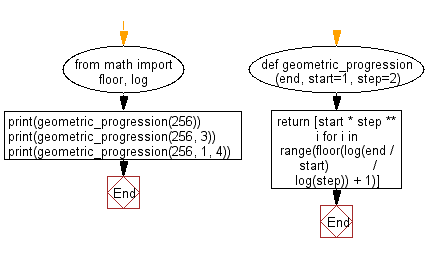Python: Geometric progression
Python List: Exercise - 244 with Solution
Write a Python program to initialize a list containing the numbers in the specified range where start and end are inclusive and the ratio between two terms is step. Returns an error if step equals 1.
- Use range(), math.log() and math.floor() and a list comprehension to create a list of the appropriate length, applying the step for each element.
- Omit the second argument, start, to use a default value of 1.
- Omit the third argument, step, to use a default value of 2.
Sample Solution:
Python Code:
from math import floor, log
def geometric_progression(end, start=1, step=2):
return [start * step ** i for i in range(floor(log(end / start)
/ log(step)) + 1)]
print(geometric_progression(256))
print(geometric_progression(256, 3))
print(geometric_progression(256, 1, 4))
Sample Output:
[1, 2, 4, 8, 16, 32, 64, 128, 256] [3, 6, 12, 24, 48, 96, 192] [1, 4, 16, 64, 256]
Flowchart:

Visualize Python code execution:
The following tool visualize what the computer is doing step-by-step as it executes the said program:
Python Code Editor:
Have another way to solve this solution? Contribute your code (and comments) through Disqus.
Previous: Write a Python program to check if a given function returns True for every element in a list.
Next: Write a Python program to that takes any number of iterable objects or objects with a length property and returns the longest one.
What is the difficulty level of this exercise?
Test your Programming skills with w3resource's quiz.
Python: Tips of the Day
Find current directory and file's directory:
To get the full path to the directory a Python file is contained in, write this in that file:
import os dir_path = os.path.dirname(os.path.realpath(__file__))
(Note that the incantation above won't work if you've already used os.chdir() to change your current working directory, since the value of the __file__ constant is relative to the current working directory and is not changed by an os.chdir() call.)
To get the current working directory use
import os cwd = os.getcwd()
Documentation references for the modules, constants and functions used above:
- The os and os.path modules.
- The __file__ constant
- os.path.realpath(path) (returns "the canonical path of the specified filename, eliminating any symbolic links encountered in the path")
- os.path.dirname(path) (returns "the directory name of pathname path")
- os.getcwd() (returns "a string representing the current working directory")
- os.chdir(path) ("change the current working directory to path")
Ref: https://bit.ly/3fy0R6m
- New Content published on w3resource:
- HTML-CSS Practical: Exercises, Practice, Solution
- Java Regular Expression: Exercises, Practice, Solution
- Scala Programming Exercises, Practice, Solution
- Python Itertools exercises
- Python Numpy exercises
- Python GeoPy Package exercises
- Python Pandas exercises
- Python nltk exercises
- Python BeautifulSoup exercises
- Form Template
- Composer - PHP Package Manager
- PHPUnit - PHP Testing
- Laravel - PHP Framework
- Angular - JavaScript Framework
- Vue - JavaScript Framework
- Jest - JavaScript Testing Framework
